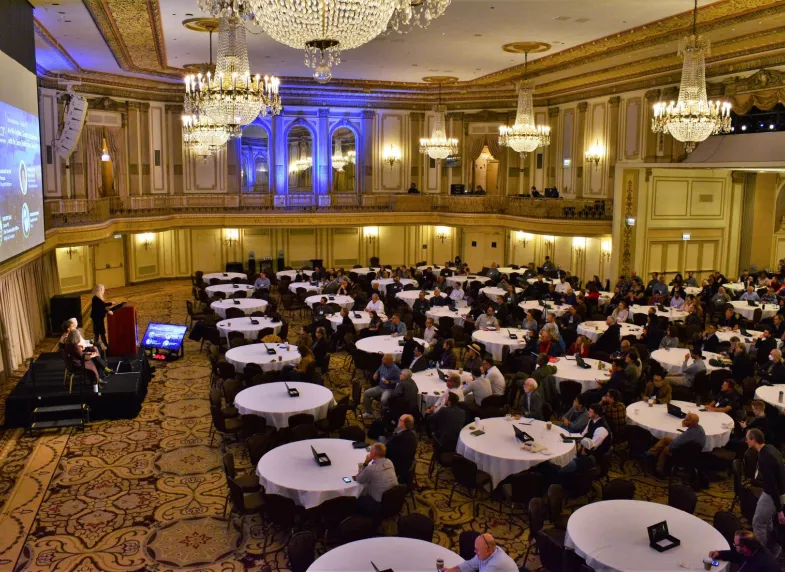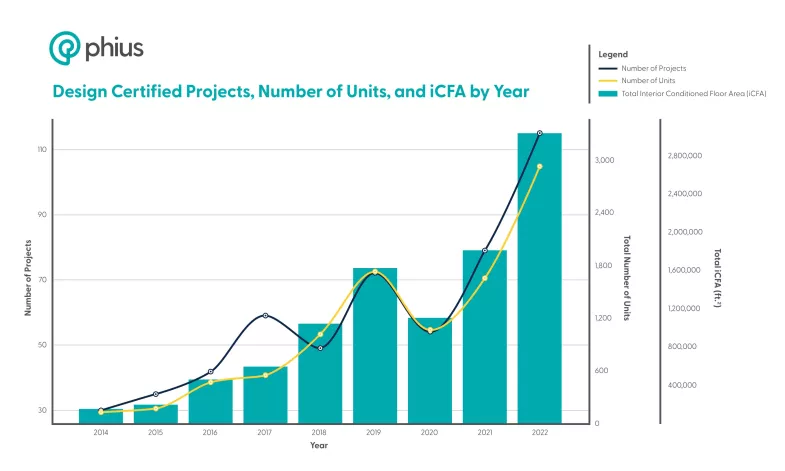Refocusing the Mission, Revamped Website, and Retrofits: Phius 2022 Year in Review
We take a look back at our accomplishments in 2022, and highlight our plans and goals for 2023.
We take a look back at our accomplishments in 2022, and highlight our plans and goals for 2023.

At Phius, the most critical year is always the next one.
Since our inception, we have been a forward-thinking organization. We set out to mitigate and adapt to the effects of the climate crisis in the most effective way we knew how – through the built environment.
The existing building stock consumes a staggering amount of energy, but thanks to the innovation and courage of some of the smartest minds in building science, we realized it didn’t have to be that way. There is a better way to build. And the best part is that it doesn’t require any yet-to-be-developed technology – we could do it right now. So that is what we did.
The list of goals we’ve accomplished just this year, along with our dedicated community of professionals, is long enough to fill several blogs. But for the sake of brevity, we narrowed the list below to include our most noteworthy accomplishments of 2022.

As we put the successes of 2022 in the rearview mirror, we began turning our attention toward the future. We asked ourselves a simple question: how can we improve as an organization? In doing so, we discovered a minor change that could unlock countless previously overlooked opportunities.
Our longtime stated mission was to make high-performance passive building the mainstream market standard. This mission served us well as we developed the Phius standard, trained our army of professionals and fought for policy adoption throughout the country, but as our organization evolved, we realized it may not capture the entire picture.
With 2023 on the horizon, we have adjusted our mission statement to better encapsulate what we at Phius are working toward: to create a built environment that supports the health of people and planet. Simply put: zero is the goal, and Phius is the means.
This is not a shift away from our initial mission, but rather a reframing in order to more accurately describe our work. To be clear, advancing the Phius standard and getting it written into as much legislation as possible will be one of, if not our largest, tool as we seek to create a healthier building stock. But as we look toward 2023 and beyond, that is just the start.
One thing that’s been clear to Phius and other entities working to advance a low-carbon agenda: Young people don’t need to be convinced of the importance of reducing the footprint of the built environment. They eat it up! Consequently, we will be engaging our university partners and growing our relationships with educators as we look to integrate Phius building principles into architecture school curriculums around the country.
Similarly, we will look to expand our community of Phius professionals even further, both by increasing trainings (specifically for quality assurance pros) as well as through membership in the Phius Alliance.
What has us most excited about 2023 is the progress being made on the new Phius REVIVE retrofit standard. Bringing the existing building stock up to Phius or similar energy efficiency levels is one of the primary challenges facing the green building industry, and one to which we have dedicated much time and effort. The solution is not as simple as retrofitting all existing buildings to meet Phius standards. Not only is this not economically or logistically feasible in many cases, but it would also create a dangerous amount of carbon emissions in a very short period of time.
To help weigh the carbon impact of Phius REVIVE retrofits, our technical staff created a new measurement for carbon accounting called the Annualized Decarbonization of Retrofitted Building (ADORB) cost. Another issue facing the effort of mass-retrofits is simply the unique nature of each building. Buildings have different issues that need to be addressed when retrofitting, which is why the new Phius REVIVE employs more of a “mass customization” strategy rather than a one-size-fits-all approach.
Many more details on ADORB cost and the Phius REVIVE program as a whole will be discussed during our Spring Retrofit Summit that is scheduled for late March. The year 2023 is shaping up to be “The Year of the Retrofits” at Phius, and we can’t wait to get it rolling.
But retrofits aren’t all that’s on the horizon here at Phius. We will be hosting policy-focused meetings for Alliance members as well as webinars hosted by Phius staff that will be focused on topics such as windows, plumbing, calculators and more.
Next year also promises to be a critical year for the Phius Certified Products programs. The Commercial Ventilator program is scheduled to launch in early 2023, and the Phius Certified Windows database will be entirely refreshed. Window data in the new database will be searchable, sortable, filterable, traceable, and better organized, making it significantly more useful for both practitioners and manufacturers.
Our programs will also see a revamping in 2023, with the most critical update coming to the Phius Certified Consultant (CPHC®) Phase I training curriculum. The update will keep the material up to date with best practices and the latest case studies, as well as provide a fresh look and feel to the material.
The Phius research team will continue its groundbreaking work as we move into the new year as well, with Phius/Grid-Integrated building and the new Phius REVIVE standard at the forefront of those efforts. We’ll also be exploring an enhanced building energy modeling tool and potential connections with other tools.
In our industry, there are never enough hours in the day or days in the year. But with the help of our dedicated, innovative and ever-growing community, we are confident we can meet and overcome the challenges that lay ahead. And as always, that starts with the most critical year we’ve faced – the next one.